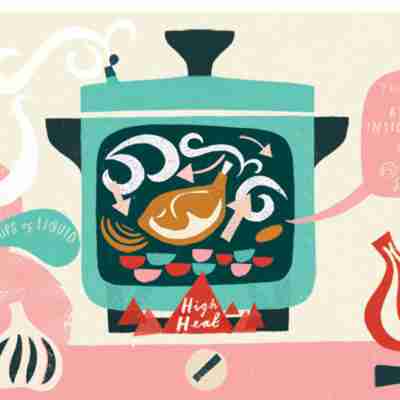With so many people looking for new ways to make dinner quicker these days, it’s a wonder that pressure cookers aren’t more popular. These pots radically cut cooking times, making it possible to cook whole grains, beans, and even soul-warming stews on a weeknight. Plus, today’s pressure cookers are super safe and a snap to use.

How does a pressure cooker work?
A pressure cooker looks like a regular pot but has a modified lid that locks on over a rubber gasket to create a seal. The cooker works by raising the temperature of boiling water, thereby speeding up the time it takes to boil, braise, or steam. To use a pressure cooker, you put the food in the pot with some liquid-usually a minimum of 2 cups to build up sufficient steam pressure. Once the lid is locked in place and the cooker is set on high heat, steam develops in the pot and can’t escape. The trapped steam increases the atmospheric pressure inside the cooker by 15 pounds per square inch (psi), or 15 pounds above normal sea-level pressure. At that pressure, the boiling point of water is increased from 212°F to 250°F. This higher temperature is what cooks food faster. Once the cooker has reached full pressure, usually indicated by a gauge or pop-up rod on the lid, a release valve opens, letting out steam in a regulated flow to maintain a constant temperature inside the pot.
Most stovetop pressure cookers are preset at 15 psi, but some models provide a lower setting as well, between 10 and 11 psi, or about 235°F. (This lower setting is helpful for delicate foods like puddings, for example.)
There are also electric pressure cookers. Many of these models can be set to varying pressures and temperatures, and can be programmed to move from low temperature for soaking beans and whole grains to higher temperatures for cooking.
What are the pros and cons of pressure cooking?
A pressure cooker cooks food about 30 percent faster than conventional methods like steaming, boiling, and braising. According to the American Council for an Energy-Efficient Economy, pressure cookers also use 50 to 75 percent less energy due to shorter cooking times. Pressure-cooked foods retain more vitamins and minerals (as well as flavor) than boiled foods because there is less water into which nutrients can dissolve.
Pressure cookers are especially useful for cooking at high altitudes. As elevation increases, atmospheric pressure decreases, causing water to boil at lower temperatures, which lengthens cooking times. But a pressure cooker provides constant, precise atmospheric conditions inside the cooker, reducing cooking times even at high altitudes.
A pressure cooker does take some getting used to-it’s not simply a pot with a lid. For instance, you’ll need less liquid than usual to cook a typical stew or soup because there is little to no evaporation, but too little liquid can cause scorching on the bottom of the cooker. Also, checking doneness isn’t as simple as lifting the lid. For safety, the lid is locked on while at full pressure, and you have to release the pressure before you can lift the lid. This can lengthen the total cooking time if you then have to put the lid back on and return the cooker to full pressure. Finally, food can easily overcook if left in the pressure cooker for just a few minutes too long.
What are the best foods to cook in a pressure cooker and why?
Pressure cooking is a moist-heat cooking method, so foods that taste good boiled, braised, or simmered work best. Good options include soups, stews, and stocks; dried beans, whole grains, risotto, polenta, and grits; dense vegetables like beets and carrots; and meats you might otherwise consider for braising, like beef chuck, pork shoulder, or chicken parts.
Pressure cooking these foods causes their proteins to denature, their starches to gelatinize, and their fibers to soften in about one-third the time they would under normal atmospheric pressure. For example, hard dried beans, like chickpeas, which normally take more than an hour to cook, can be pressure cooked in about 20 minutes. A full-flavored beef stock that would normally simmer for the better part of a day can be pressure cooked in an hour, and risotto is ready in about 10 minutes.
How you release the pressure plays an important role in the cooking process. There are three basic pressure-release methods: natural release, achieved by turning off the heat and letting the pressure drop naturally; running the pot under cold water; and quick release, which means manually opening the release valve on your cooker. Natural release takes 5 to 20 minutes, depending on the quantity and density of the ingredients; it works best for foods like braised meats and dried beans, which benefit from a resting period after cooking and tend to break apart during rapid depressurization. Both the cold water and quick release methods rapidly depressurize the cooker and are ideal for most vegetables and grains, which can easily overcook.
Reliable recipes are key to good pressure cooking, since accurate timing is critical to preventing overcooking or undercooking. Consult your cooker’s manual and start timing when the cooker has reached full pressure. To be on the safe side, slightly underestimate the total cooking time. You can always apply more heat and pressure to finish cooking, but you can’t undo overcooking. If you release the pressure to check on the food and find that it needs more time, simply put on the lid and simmer for a few minutes or lock the lid back in place and return the cooker to full pressure.
Pressure Cookers Are Now Fail-Safe
In the 1950s, pressure cookers were commonplace in American kitchens, but stories of cookers exploding because of improper sealing scared people off. By the 1970s, pressure cooking in the United States largely became a thing of the past, thanks to frozen dinners and other convenient meal solutions. (In Europe, where such items were not as popular, the pressure cooker remained a preferred way to speed up mealtime.)
All pressure cookers are now fail-safe. They come equipped with a backup vent or an overpressure plug that releases excess pressure in case you forget to turn down the heat after the pot reaches full pressure, or if the main vent becomes clogged with food during cooking. An expanding rubber gasket sitting inside the lid also makes it impossible to unlock and remove the lid until the pressure inside the cooker has been released.
Each time you use your pressure cooker, check the rubber gasket to make sure it’s flexible-not dry-and free of cracks to ensure a tight seal. Periodically, make sure the main vent is clear by running warm water through it, and check to see that the overpressure plug or back-up vent is clear. When removing the lid after releasing pressure, it’s also a good idea, as with any hot pot, to tilt the lid so that it acts as a shield between you and residual steam rising from the cooker.












